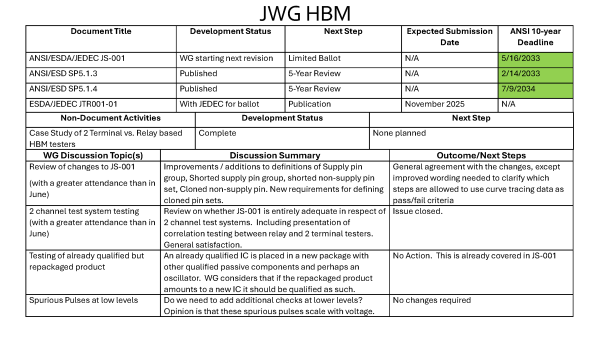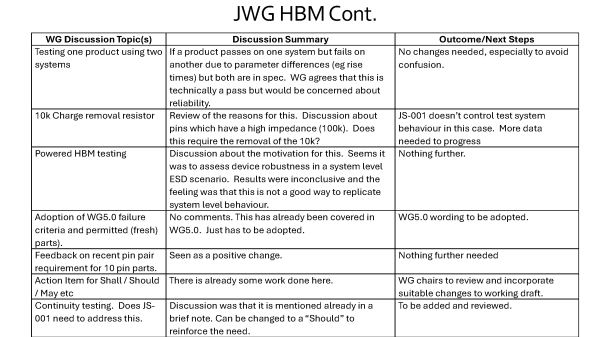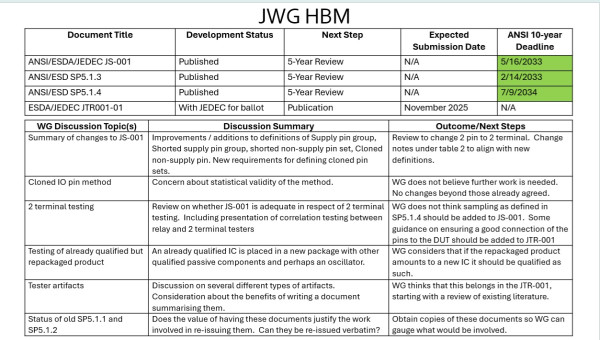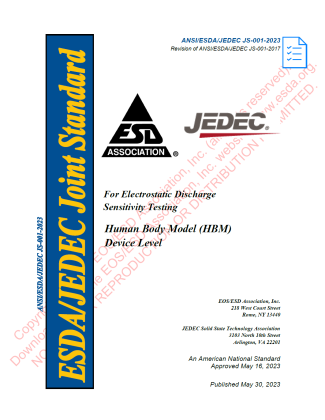JWG – Human Body Model (HBM) Device Testing
- Status:
- Active
- Working Group Chair:
- Co-Chairs: Andrea Boroni, STMicroelectronics; Scott Ward, Texas Instruments
-


-

-

-
Documents in review
- ANSI/ESDA/JEDEC JS001à 2024 ready for publication
- Introduced an alternative decay time calculation method.
- Created better waveform verification equipment specifications.
- Created better descriptions of pre-pulse voltage rise detection test and trailing pulse detection apparatus.
- ESD JTR001-01-xx – User Guide à TAS comments to be adjudicated
- Complete review (JS001 alignment)
Current Top 3 WG activities
- Pin Grouping and Resistance Measurement Review (for next full review)
- Cloned IO allowance review (for next full review)
- JTR-001 comments adjudication
- Pin Grouping and Resistance Measurement Review
- Definitions and allowances
- Supply Pin Group à metal < 3 Ohms
- Shorted Supply Pin Group à metal < 1 Ohm (including not APL)
- Shorted Non-Supply Pin Group à metal regardless resistance value
- Definitions and allowances
- Cloned IO
- More accurate definition
- Engineering judgment on applicability of the methodology
- Suggestion for additional pins to be selected based on design to confirm normally distribute failure
- ATE in addition to curve trace for functional failure
- ATE @ 1.5SPL and V1 (one additional part)
- Round Robin testing to elevate SP5.1.4 to STM5.1.4
- No parts available
- 500R evaluation load bandwidth
- Resistance with different bandwidth (VNA measurement)
- trr = 11.15 ns to 44.11
- Current note: Care should be used in the selection of the 500-ohm resistor to avoid resistors with high inductance, such as wire wound resistors, or resistors with high parallel capacitance.
- Additional requirements needed?
- JS001 Next Full Revision
- Supply pin group, shorted supply pin group, shorted non-supply pin set
- Definition and allowances
- Cloned IO
- Definition, methodology applicability, ATE to confirm failure
- Incorporate JTR reference
- Definition: “positive clamp test socket” and "non-positive clamp fixtures“
- Shall/Should use parts already used for another test à WG 5.0 DONE
- Failure criteria à WG 5.0
- Caution changing test table or pin association to discount failure
- Table B N+1 stress with two-channel tester DONE
- Shorted supply pins à allowance to have all connected to one tester channel
- Supply pin group, shorted supply pin group, shorted non-supply pin set
- ANSI/ESDA/JEDEC JS001à 2024 ready for publication
-
The WG discussed pin grouping and resistance measurements as well as reviewed cloned I/O allowance. The group also discussed round robin testing for ANSI/ESD SP5.1.4 - A Method for Random Sampling of Power Pins.
-
During the meeting, the JWG reviewed the status of JS-001 LB, adjudicated STDCOM comments on WIP5.1.4-203, and discussed Cloned IO/Pin Grouping/Exclude criteria 3 ohms/1 ohm.
-
-
The WG adjudicated the TAS comments on the limited ballot on JS-001. There was also a discussion on the alternative Cloned IO method allowed within the document.
- Information was given that stated a problem was discovered when using this method, which brings the method into question.
- Additional information will be gathered on this issue to determine if changes need to be made.
A status was given on the updates being made to the ESDA/JEDEC JTR001 User Guide document.
- Additional work is continuing within the writing team, and once they have a version ready, it will be provided to the entire WG for review prior to moving forward towards release.
-
-
The WG reviewed modifications made for the limited ballot of JS-001, including:
- Introduction of an alternative Decay Time calculation method
- Better waveform verification equipment specifications
- Better descriptions of the pre-pulse voltage rise detection test and trailing pulse detection apparatus
- New order of Annex D Figures for better alignment with logical flow
- Cloned IO definition and flow revision
- Minor editorial changes
WG adjudicated TAS comments on ANSI/ESD SP5.1.3-2023 – A Method for Randomly Selecting Pin Pairs and WIP SP5.1.4 – Random Sampling of Power Pins. A review was also given on the status of the ESDA/JEDEC JTR001, Users Guide.
-
The WG adjudicated TAS comments of ESD SP5.1.4 “Random Sampling of Power Pins”. The document will be sent to headquarters. An update on JTR001 User Guide was provided - work is still ongoing with the hopes of releasing it along with JS-001 by the end of 2023. The status of ANSI/ESDA/JEDEC JS-001 HBM was also discussed, awaiting the JEDEC BoD vote. The group discussed a question on cloned IO pin criteria, awareness of many allowances, and impact on HBM results; further user guide discussion is planned.
-
The WG adjudicated the industry review and JEDEC ballot comments on the five-year update of ANSI/ESDA/JEDEC JS-001, “HBM”. These changes are will be sent to STDCOM for a recirculation vote. TAS comments on the five-year review of ANSI/ESD SP5.1.4 “Random Sampling of Power Pins” were reviewed and adjudicated. ANSI/ESD SP5.1.3 “Statistical pin pair combination” will be sent to TAS with a recommendation for reaffirmation. The JWG discussed the proposal to update the decay time measurement method to move from a linear-based calculation to an exponential-based calculation for the next revision of ANSI/ESDA/JEDEC JS-001. Data was presented which showed the differences in results between these two calculation methods. The JWG also discussed proposals for the “discharge all pins” and charge removal allowances within ANSI/ESDA/JEDEC JS-001 and how these should be updated within the document.
-
The JWG discussed the proposal to update the decay time measurement method to move from a linear-based calculation to an exponential-based calculation for the next revision of ANSI/ESDA/JEDEC JS-001. Data was presented which showed the differences in results between these two calculation methods.
The JWG also discussed proposals for the “discharge all pins” and charge removal allowances within ANSI/ESDA/JEDEC JS-001 and how these should be updated within the document.
ANSI/ESD SP5.1.3 was also reviewed with some minor edits.
-
The WG focused on review of TAS comments on the JS-001 “Human Body Model (HBM) – Component Level” document. All comments were adjudicated except for the definitions of VW, V1V2 and a Note on Figure 4. These items will be reviewed in subsequent conference calls or face to face meetings.
WG is also working on changes to the JTR-001 HBM Users Guide and WIP5.1.4 Random Sampling of Power Pins. Additionally, they will be looking at possible changes to SP5.1.3 A Method for Randomly Selecting Pin Pairs, which is up for its 5-year review.
-
The joint committee adjudicated TAS comments on the five year review revisions of ANSI/ESDA/JEDEC JS-001. The group discussed wafer level testing and the status of an update to the user guide technical report.
-
The joint committee adjudicated TAS comments on ESDA/JEDEC JWIP-001-2021. Additional updates will be made to ESDA/JEDEC JTR-001 – User Guide.
-
The joint committee reviewed the ongoing revisions to ESDA/JEDEC JTR-001 – User Guide. This next revision will be a companion document to ANSI/ESDA/JEDEC JS-001. Current revisions to ANSI/ESDA/JEDEC JS-001 during the five-year review will be sent for TAS review before the June meeting series. There was a discussion on “delay between pulses”.
-
Summary of meeting activities:
The joint committee adjudicated WG comments on the five-year review of ANSI/ESDA/JEDEC JS-001.
